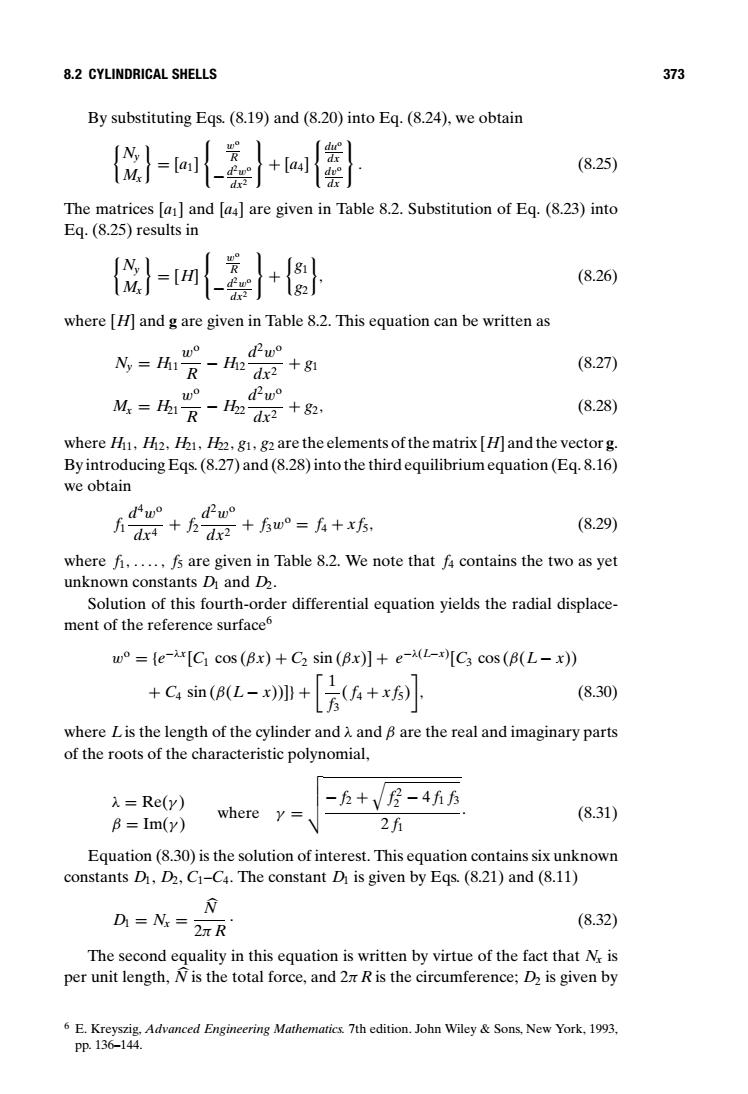正在加载图片...

8.2 CYLINDRICAL SHELLS 373 By substituting Eqs.(8.19)and(8.20)into Eq.(8.24),we obtain }-}+ (8.25) The matrices [a]and [a4]are given in Table 8.2.Substitution of Eq.(8.23)into Eq.(8.25)results in =}+ (8.26) where [H]and g are given in Table 8.2.This equation can be written as P2w =H1R-H2+81 (8.27) w dPw° M,=1R-d+82, (8.28) where H,H2,H1,H2.g1,g2are the elements of the matrix [and the vectorg. By introducing Eqs.(8.27)and (8.28)into the third equilibrium equation(Eq.8.16) we obtain d4w°.edPw° h4+hd+后w°=店+x5, (8.29) where fi.....,fs are given in Table 8.2.We note that f contains the two as yet unknown constants D and D2. Solution of this fourth-order differential equation yields the radial displace- ment of the reference surface5 wo=(e-ix[Ci cos(Bx)+C2 sin(Bx)]+e-(L-[C3 cos(B(L-x)) +cm(L-加+[房6+ (8.30) where L is the length of the cylinder and A and B are the real and imaginary parts of the roots of the characteristic polynomial, λ=Re(y) -五+√经-4iB where (8.31) B Im(y) 2f Equation (8.30)is the solution of interest.This equation contains six unknown constants D,D2,C1-C4.The constant Di is given by Eqs.(8.21)and(8.11) N D =Nx 27R (8.32) The second equality in this equation is written by virtue of the fact that M is per unit length,N is the total force,and 2m R is the circumference;D2 is given by 6 E.Kreyszig.Advanced Engineering Mathematics.7th edition.John Wiley Sons,New York,1993, Pp.136-144.8.2 CYLINDRICAL SHELLS 373 By substituting Eqs. (8.19) and (8.20) into Eq. (8.24), we obtain
Ny Mx = [a1] 1 wo R −d2wo dx2 6 + [a4] 1duo dx dvo dx 6 . (8.25) The matrices [a1] and [a4] are given in Table 8.2. Substitution of Eq. (8.23) into Eq. (8.25) results in
Ny Mx = [H] 1 wo R −d2wo dx2 6 +
g1 g2 , (8.26) where [H] and g are given in Table 8.2. This equation can be written as Ny = H11 wo R − H12 d2wo dx2 + g1 (8.27) Mx = H21 wo R − H22 d2wo dx2 + g2, (8.28) where H11, H12, H21, H22, g1, g2 are the elements of the matrix [H] and the vector g. By introducing Eqs. (8.27) and (8.28) into the third equilibrium equation (Eq. 8.16) we obtain f1 d4wo dx4 + f2 d2wo dx2 + f3wo = f4 + x f5, (8.29) where f1,...., f5 are given in Table 8.2. We note that f4 contains the two as yet unknown constants D1 and D2. Solution of this fourth-order differential equation yields the radial displacement of the reference surface6 wo = {e−λx[C1 cos (βx) + C2 sin (βx)] + e−λ(L−x) [C3 cos (β(L− x)) + C4 sin (β(L− x))]} + 1 f3 ( f4 + x f5) ! , (8.30) where Lis the length of the cylinder and λ and β are the real and imaginary parts of the roots of the characteristic polynomial, λ = Re(γ ) β = Im(γ ) where γ = 7889− f2 + $ f 2 2 − 4 f1 f3 2 f1 . (8.31) Equation (8.30) is the solution of interest. This equation contains six unknown constants D1, D2, C1–C4. The constant D1 is given by Eqs. (8.21) and (8.11) D1 = Nx = N 2π R . (8.32) The second equality in this equation is written by virtue of the fact that Nx is per unit length, Nis the total force, and 2π R is the circumference; D2 is given by 6 E. Kreyszig, Advanced Engineering Mathematics. 7th edition. John Wiley & Sons, New York, 1993, pp. 136–144